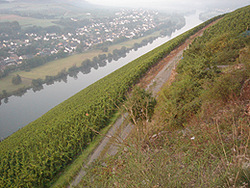Brauneberg
| Brauneberg | |
|---|---|
 |
|
| Coordinates: 49°54′30″N 6°59′07″E / 49.90833°N 6.98528°ECoordinates: 49°54′30″N 6°59′07″E / 49.90833°N 6.98528°E | |
| Country | Germany |
| State | Rhineland-Palatinate |
| District | Bernkastel-Wittlich |
| Municipal assoc. | Bernkastel-Kues |
| Government | |
| • Mayor | Klaus Denzer |
| Area | |
| • Total | 12.22 km2 (4.72 sq mi) |
| Elevation | 124 m (407 ft) |
| Population (2015-12-31) | |
| • Total | 1,165 |
| • Density | 95/km2 (250/sq mi) |
| Time zone | CET/CEST (UTC+1/+2) |
| Postal codes | 54472 |
| Dialling codes | 06534 |
| Vehicle registration | WIL |
| Website | www.brauneberg.de |
Brauneberg is an Ortsgemeinde – a municipality belonging to a Verbandsgemeinde, a kind of collective municipality – in the Bernkastel-Wittlich district in Rhineland-Palatinate, Germany. It is known above all for its wine and its meteorological distinctions.
The municipality lies on the Moselle near Bernkastel-Kues. It belongs to the Verbandsgemeinde of Bernkastel-Kues, whose seat is in the town of the same name.
Here on 11 August 1998, the highest ever temperature in Germany was measured, 41.2 °C, at the Meteomedia weather station by Jörg Kachelmann. Nevertheless, Brauneberg is not said to be Germany’s number-one hotspot because the weather station is not included in official measurements owing to its location on a slate mountain.
Brauneberg’s Ortsteile are Brauneberg, Filzen and Hirzlei.
Although the outlying centre of Hirzlei is indeed an integral part of Brauneberg, there is no direct road linking it to the main centre. The village representative – Ortsvorsteher – of Hirzlei is Ewald Adam.
The name Brauneberg is first mentioned in documents dating 588. The old placename, Dusemond, may well have stemmed from what one of the vineyards here was called in Roman times: dulcis mons (Latin for “sweet mountain”). In 1925, the village’s name was changed to Brauneberg.
Dusemond belonged to the old County of Veldenz, into which Count Palatine Louis II introduced the Reformation in 1523. In the Thirty Years' War, the Prince-Archbishop-Elector of Trier seized ownership of the village. Only with the 1648 Peace of Westphalia was the Count of Veldenz reinstated with all his old rights, whereby the village’s parish once more became Protestant. With the occupation of the County of Veldenz by France in 1680, however, the situation changed yet again and there arose a dispute over Catholics’ status within the County. By decree, the French settled the situation on 21 December 1684: Under its terms, in places with only one church – such as was the case in Dusemond – this would be given over to use by both denominations. The local church thus became a simultaneous church. Only in 1955 did this change, when it was decided to divide the church and separate it structurally. Since then, one third of the church has been used by the Evangelical congregation and the other two thirds by the Catholics. This matches the shares of the cost paid by each for the building of today’s church, which was completed in 1777.
...
Wikipedia


